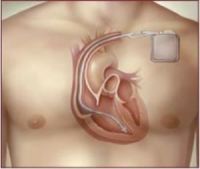Publication
Article
Internal Medicine World Report
Preventive Implantable Cardioverter-defibrillators Improve Survival in Heart Failure Patients
Author(s):
A retrospective cohort study of Medicare beneficiaries hospitalized for heart failure with a left ventricular ejection fraction between 30-35% found improved 3-year survival rates among those who received a prophylactic implantable cardioverter-defibrillators compared to those with no ICD.

A retrospective cohort study of Medicare beneficiaries hospitalized for heart failure (HF) with a left ventricular ejection fraction (LVEF) between 30-35% found improved 3-year survival rates among those who received a prophylactic implantable cardioverter-defibrillators (ICD) compared to those with no ICD.
The study, which was published June 4, 2014, in JAMA, supported current guidelines recommending the implantation of prophylactic ICDs in eligible patients with an LVEF of 35% or less.
For their research, Sana M. Al-Khatib, MD, MHS, of the Duke University Medical Center, and colleagues examined patients from the National Cardiovascular Data Registry’s ICD Registry with LVEF between 30-35% who received an ICD during a HF hospitalization, as well as similar patients from the Get with the Guidelines-Heart Failure (GWTGHF) database who did not receive an ICD. The investigators also analyzed patients in both databases who had an LVEF <30%.
A total of 3,120 HF patients with an LVEF between 30-35% and 4,578 HF patients with an LVEF <30% were analyzed on the primary outcome of all-cause mortality. Among those with an LVEF between 30-35%, there were 248 deaths in the ICD Registry group within a median follow-up of 4.4 years, and 249 deaths in the GWTGHF group within a median follow-up of 2.9 years.
Thus, the researchers concluded the risk of all-cause mortality in patients with an LVEF between 30-35% and an ICD was significantly lower compared to matched patients without an ICD. The presence of an ICD was also associated with improved 3-year survival in patients with an LVEF <30%.






